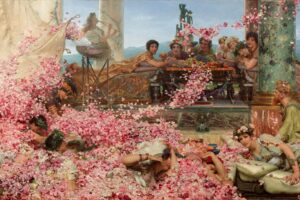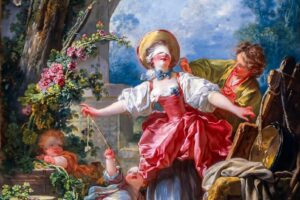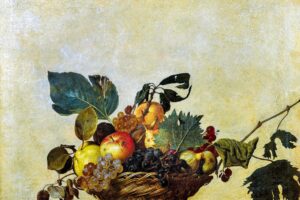Table of Contents
Overview
Painted in 1873 by John Roddam Spencer Stanhope (1829–1908), The Gentle Music of a Bygone Day is a poetic canvas inspired by William Morris’ The Earthly Paradise. The scene shows two women in a serene countryside: one strums a lute while the other reads from an illuminated manuscript, crowned with flowers like a muse of poetry. Together, they embody the union of music, literature, and memory — the gentle arts of ages past.
The lush landscape, soft light, and symbolic harmony of figures and nature reflect Stanhope’s Pre-Raphaelite ideals. The painting captures a wistful longing for an earlier world, an imagined time where art and life were intertwined with grace and devotion.
This work was exhibited to acclaim for its delicate symbolism and luminous detail, reminding Victorian audiences of the enduring beauty of medievalism, myth, and poetry. Today, it remains a quintessential Pre-Raphaelite meditation on the arts and their power to transcend time.
Artist
John Roddam Spencer Stanhope (1829–1908) was a British painter closely aligned with the Pre-Raphaelite Brotherhood. He trained under George Frederic Watts and was influenced by Dante Gabriel Rossetti and Edward Burne-Jones. His paintings often blended allegory, mythology, and literature, using jewel-like colors and symbolic figures. Later settling in Florence, Stanhope became part of the Anglo-Florentine artistic circle, where his work fused Italian influences with English Romantic ideals.
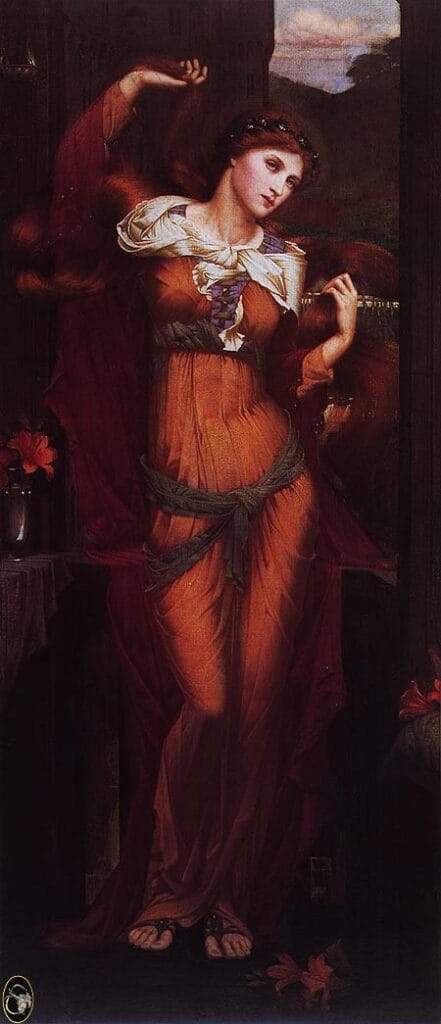
The Story Behind the Painting
Inspired by William Morris
The painting takes its theme from William Morris’ The Earthly Paradise, a cycle of poems that celebrates myth, legend, and the passage of time. Stanhope translates Morris’ nostalgic tone into imagery: music and poetry as twin voices of memory.
The Two Figures
The standing woman, clothed in rich crimson and violet, plays the lute, her gaze distant as if lost in reverie. The seated figure, crowned with blossoms, leans over an illuminated manuscript — a symbol of literary tradition. Together, they represent a dialogue between song and story.
A Bygone Age
The title evokes the wistful passing of time. Just as Morris’ poetry longs for an earthly paradise of beauty and meaning, Stanhope’s canvas mourns and celebrates the “bygone day” when art was lived as much as it was created.
Composition and Subjects
The Musicians
The lute-player anchors the composition, her body upright against the trunk of a tree, a figure of artistic continuity. The reader, more relaxed, embodies inspiration received through text and memory.
The Landscape
Rolling green hills, a river winding through the distance, and a stone bridge frame the scene in an idyllic natural world. Nature here is not just backdrop but partner in harmony.
Symbolic Details
- Lute: The voice of music, memory, and longing.
- Book: A manuscript of poetry and tradition.
- Flower Crown: Inspiration, the fleeting beauty of time.
Art Style and Techniques
Pre-Raphaelite Detail
The jewel-toned gowns, textured bark, and patterned manuscript reflect the Brotherhood’s dedication to precision and color.
Symbolist Harmony
The work blends literal scene with allegorical mood, typical of Stanhope’s later style influenced by Burne-Jones.
Fusion of Arts
Stanhope unites literature, music, and painting, echoing the Pre-Raphaelite ambition to bring together all the arts in one vision of beauty.
Featured in Our Collection
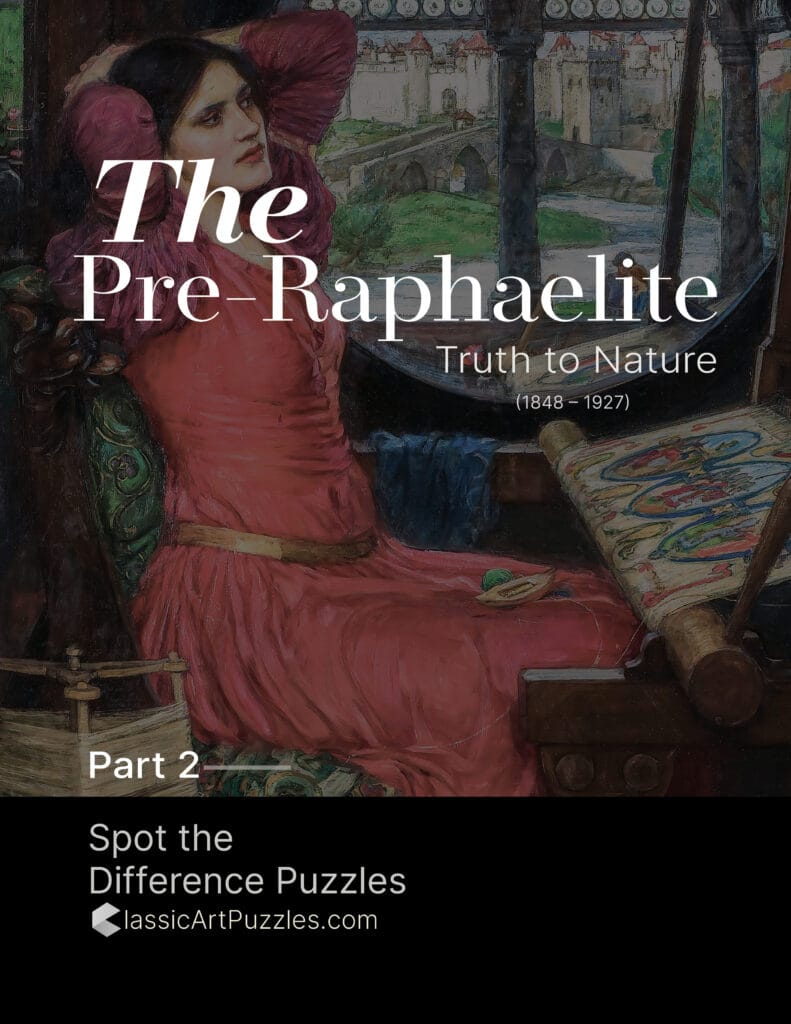
The Gentle Music of a Bygone Day is part of our Pre-Raphaelite Spot-the-Difference Puzzle Flipbook P2. Its intricate manuscript, delicate flowers, and glowing fabrics make it an enchanting puzzle. Each discovery echoes the Victorian fascination with poetry, music, and memory brought to life through art.
The Gentle Music of a Bygone Day
Two women beneath a tree, one singing through her lute, the other murmuring words from a golden page. In Stanhope’s The Gentle Music of a Bygone Day, poetry and music become a bridge between past and present, between memory and paradise.
More About Artist
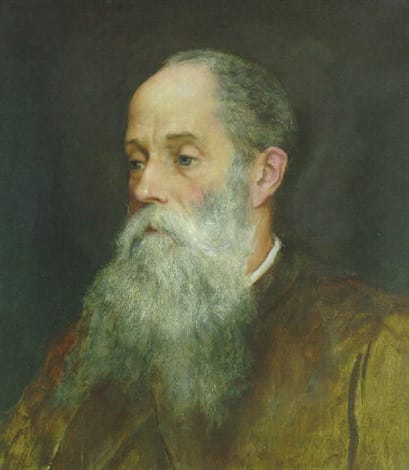
John Roddam Spencer Stanhope (January 20, 1829 – August 2, 1908) was an English artist associated with the second wave of the Pre-Raphaelite movement. Born into an aristocratic family in Cawthorne, Yorkshire, he was educated at Rugby School and Christ Church, Oxford. Despite his privileged background, Stanhope pursued a career in art, training under George Frederic Watts and traveling extensively, including trips to Italy and Asia Minor.
Artist Style and Movement
Stanhope’s work is typically classified within the later Pre-Raphaelite and Aesthetic movements of Victorian art. He worked across various media—oil, watercolor, fresco, tempera—and his subjects ranged from mythological and allegorical themes to biblical scenes and contemporary life. His early paintings featured highly original narrative compositions, which later evolved towards a more symbolic and aesthetic style influenced by broader Victorian artistic trends.
The Pre-Raphaelite Society continues to explore and share the legacy of this remarkable movement.
Artwork Profile
- Thoughts of the Past (1859), his first exhibited painting, depicting a contemplative woman by a window overlooking the Thames.
- The Shulamite: (Pastoral Scene with Lambs) (c. 1878), a serene and lyrical pastoral scene exemplifying his Pre-Raphaelite style.
- The Shulamite: (Bridal Procession) (c. 1882), depicting the procession with rich symbolism and ornate detail, continuing his Pre-Raphaelite themes.
- Penelope (1864), illustrating the faithful wife from Homeric legend in the detailed and expressive Pre-Raphaelite manner.
- Winnowing (c. 1880), portraying agricultural life with symbolic overtones typical of his narrative approach.
- Juliet and Her Nurse (c. 1860), a literary subject rich with emotional and dramatic qualities favored by Pre-Raphaelites.
- Why Seek ye the Living Among the Dead (1870–1899), a powerful biblical scene reflecting later symbolic and aesthetic tendencies.
- Love and the Maiden (1877), a romantic and allegorical composition showcasing his mature style.
- Charon and Psyche (1883), a mythological painting exploring themes of love and the afterlife.
- Pine Woods at Viareggio (1888), a landscape reflecting his time in Italy with delicate naturalism.
- The Gentle Music of a Bygone Day (1873), a nostalgic genre painting evoking memories and emotion.
- The Waters of Lethe by the Plains of Elysium (1880), a symbolic work referencing classical mythology and the afterlife.
John Roddam Spencer Stanhope’s artistic career reflects a rich engagement with the ideals of the Pre-Raphaelites, combined with a move towards aesthetic symbolism in later years. His work, characterized by technical skill and narrative depth, secured him a distinctive place in Victorian art history. Living much of his later life in Florence, he influenced subsequent artists including his niece Evelyn De Morgan, solidifying his legacy as a key figure bridging English Roman

